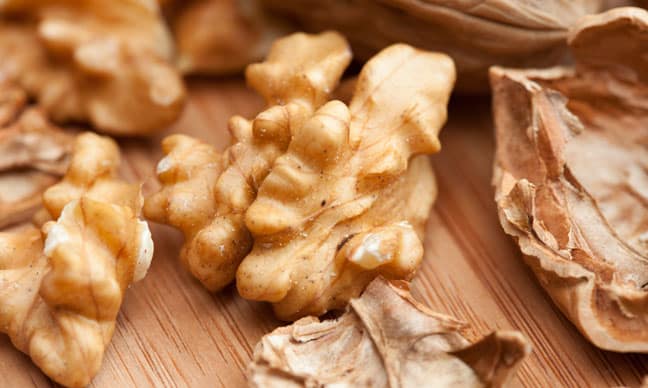Chandler walnuts are a top-selling walnut variety in Arizona. The reasons for this are the tree’s excellent nut quality and productivity. Originally, this walnut was developed by the University of California and adapted to the climate and soil of western states. Also, commercial orchards are located here, but the tree is frequently found in private lots too. Kernel statistics of this walnut show a great result, which is another reason why this walnut is so popular.
Keep reading to find out more about Chandler trees, their yield and kernel characteristics, and planting preferences!
Chandler Walnuts – Important Information
Chandler trees are semi-upright and tend to grow in a moderately vigorous way. The tree can reach about 50 feet in height in the optimal environment. However, since these trees should be pruned regularly, they will always keep a lower height.
The same applies to the horizontal size. In most cases, the branches will be pruned in a way to keep the tree’s horizontal size about 15 feet.
Chandler walnuts are suitable for high-density planting due to their size. Keep reading to learn more about tree spacing and kernel statistics.
Tree Spacing
Most tree services Arizona recommend 22 x 15 feet spacing for these walnuts. You will be able to plant about 280 trees per hectare using this spacing if you’re interested in commercial growing. When it comes to walnut trees, this planting scheme is commonly used and is called ‘Hedgerow’among owners. The main idea is to leave enough space between rows and place the trees in the same row closer to each other.
This design pattern allows high yield from an orchard in a short time and provides early returns. Another reason why owners use this method is the requirement of the pollinator of this walnut tree: Franquette. The general rule of thumb is to plant about 95% Chandler and 5% Franquette variety to get the best results from pollinating.
We recommend planting the pollinators in the same row, just for the sake of recognizing them easier once the plants grow. Of course, keep them planted upwind from the main variety so they pollinate the main variety without any problems.
Tree Yield
Chandler trees start producing walnuts a bit earlier than other varieties. It takes them only about 2 years before they produce their first walnuts. You will see fruits even after only a year since planting. Still, we recommend cutting down the fruits for at least 3 first years to improve productivity and conserve energy for the following years.
Once the walnuts start emerging, you should cut them off and not let them develop. Doing this will allow the tree to develop bigger roots and grow a stronger trunk instead of wasting energy on producing walnuts. In the long term, this increases productivity by a lot. You can start collecting the fruits after 3 years. Make sure you take notes about the number of walnuts your trees can produce in a year (when they are dry).
Related Post: Fruit Trees Arizona
The yield will increase gradually as the tree matures. Still, once the tree is about 10 years old, the levels will remain the same for a lifetime. However, the amount of walnuts a 10-year-old tree can produce is usually about 90 pounds. Of course, this is true for the trees that are grown in optimal environments.
Kernel Statistics
This walnut tree produces large nuts that weigh about half an ounce. The shell has a smooth shape and is usually about 1.5 inches in length. In general, the shell is quite sturdy and insects and birds can’t break it. In contrast, this variety is very good when it comes to human consumptions since the shell is easily breakable by hand.
Inside, this walnut variety is characterized by an excellent quality kernel, according to most tree service Arizona companies. Its color is also one of the reasons why the walnut is so popular in the area. Its internal whiteness rate is about 90%. Sometimes, this number is even bigger if the year and environment were good. Kernel weight is about 2 ounces, which means that the kernel constitutes about 50% of the walnut.
Taste is another reason for the huge interest in Chandler variety. With a 70% oil percentage of the kernel, the walnut results in a great taste preferred by a lot of people.
Care and Planting
Similar to other tree and walnut varieties, you will have to adapt to the maintenance requirements of these walnuts. It is recommended to use fertilizers, to prune the trees regularly, and of course, to prepare the land before planting.
In general, the tree is mostly pest and insect free if planted properly. Still, we recommend making regular observations and searching for disease symptoms. If you notice any, make sure you contact your local arborist and get help with further treatment. Most of the time, the tree will just need pruning and a fertilizer spray.
Related Post: Walnut Tree Disease
FAQ
Q: How many walnuts can one tree produce?
A: One Chandler tree in Arizona can produce about 90 pounds of walnuts once it hits maturity. The number of walnuts will slowly increase as the tree matures, and will eventually stay consistent once the tree is fully established. Of course, this is true if the tree is planted in the right environment and conditions.
Q: Why is walnut so expensive?
A: Walnut trees are more expansive in Arizona due to their specific condition requirements. Similar to pistachio and almond trees, they are also impacted by the drought due to their growing locations. Besides, the growing popularity of nuts also makes them more expensive in general use.
Local Tree Experts Overview
Chandler walnuts are a great choice if you’re interested in planting walnut trees. They give great results in terms of yield and kernel quality. Also, they don’t require that much maintenance and time. Still, we do recommend having an arborist by your side if you decide to plant a large number of trees.




